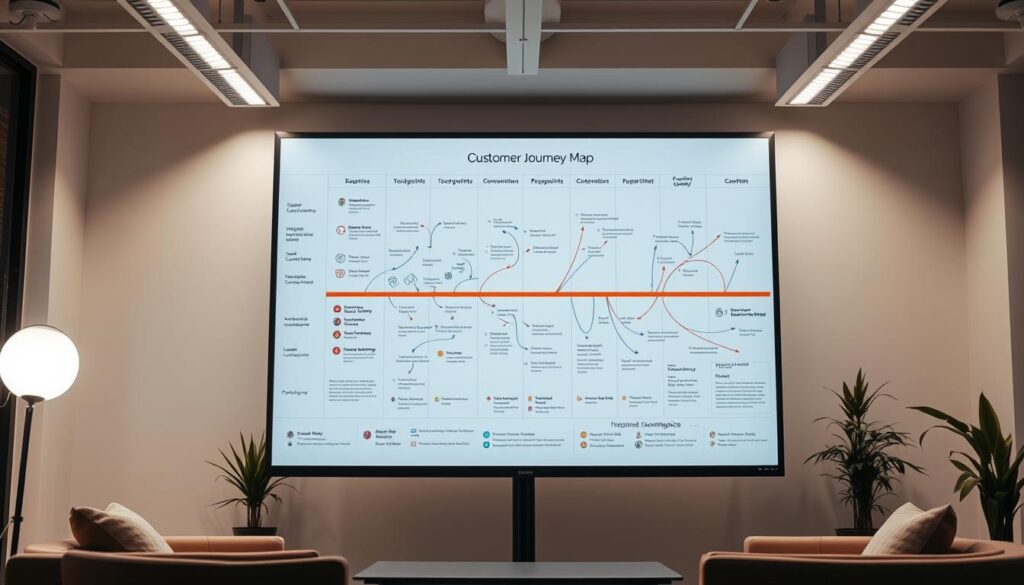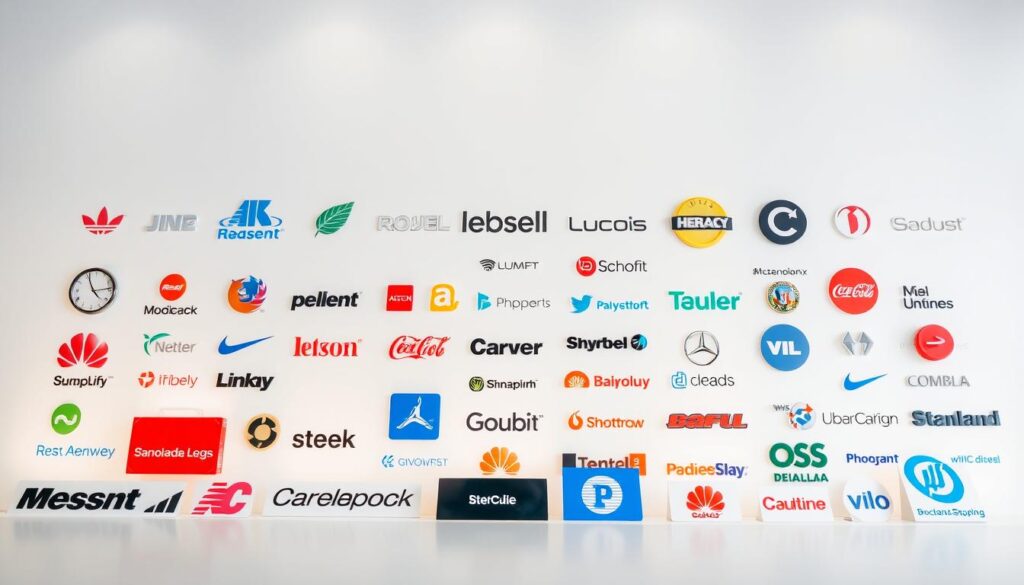A powerful business strategy starts with aligning what you offer to what customers truly need. This alignment forms the backbone of every successful product launch, guiding how teams communicate, price, and deliver solutions. Companies that master this alignment early consistently outperform competitors in crowded markets.
Many organizations treat this critical alignment as an afterthought, focusing first on campaigns or sales tactics. This approach creates fragmented messaging that confuses audiences. Research shows companies spending 30% more time refining their core message before launch achieve 2x faster market penetration.
Industry leaders like Apple and Netflix demonstrate how clarity drives growth. Their strategies don’t just explain features—they solve specific problems in memorable ways. This precision helps teams create consistent experiences across websites, ads, and sales conversations.
Without this foundation, businesses risk wasted resources and missed opportunities. A recent Gartner study found 68% of failed product launches traced their issues to unclear messaging. Continuous refinement through customer feedback turns good strategies into market-leading advantages.
Key Takeaways
- Strategic alignment between offerings and customer needs drives market success
- Core messaging development should precede campaign planning and sales efforts
- Clear communication reduces launch risks and accelerates product adoption
- Industry leaders prioritize message consistency across all customer interactions
- Ongoing refinement based on feedback maintains competitive advantage
The Critical Role of a Clear Value Proposition
Businesses thrive when their central message acts as a strategic compass, guiding every interaction with clarity. This foundational statement isn’t just marketing fluff—it’s the operational blueprint that connects solutions to real-world problems. Organizations that articulate this message effectively see 42% higher brand recall compared to competitors.
What Is a Value Proposition?
A value proposition distills how your solution improves lives better than alternatives. Unlike slogans like Nike’s “Just Do It,” it focuses on measurable outcomes rather than emotional appeal. For example, Dropbox’s “Your files, anywhere” directly addresses file accessibility pain points.
| Aspect | Value Proposition | Marketing Tagline |
|---|---|---|
| Focus | Specific customer outcomes | Brand identity |
| Content | Problem-solving details | Catchy phrases |
| Evolution | Adapts to market shifts | Remains consistent |
Why It Matters for Business Growth
Clear propositions drive decisions across departments. Sales teams convert leads 28% faster when messaging aligns with proven benefits. Product teams use them to prioritize features customers actually pay for. Companies refining these statements quarterly see 19% higher annual retention rates.
Distinguishing Your GTM Strategy from Marketing and Product Plans
Strategic planning resembles architectural design—blueprints define structures, while construction plans determine how to build them. Product marketing acts as the blueprint, detailing features and benefits. GTM strategies operate as the builder’s playbook, coordinating teams to execute launches effectively.
Understanding the Unique Focus of a Go-to-Market Strategy
Unlike product plans that emphasize what you’re selling, GTM strategies answer how you’ll deliver it to audiences. They bridge the gap between development and commercialization. For example, a SaaS company might outline pricing tiers in product docs but use GTM plans to coordinate beta testing and sales enablement.
Three core elements define these strategies:
- Timeline-driven launch sequences
- Cross-departmental task alignment
- Market-specific adaptation frameworks
Common Misconceptions and Pitfalls
Many leaders confuse GTM strategies with marketing campaigns. One tech startup wasted $500k by using their brand awareness ads for a product launch. Campaigns drive visibility—GTM plans ensure every team knows their role in converting interest into sales.
Another pitfall involves siloed planning. When sales and product teams operate separately, messaging becomes inconsistent. Regular alignment meetings prevent this. Companies with weekly cross-functional reviews see 34% fewer launch delays.
Crafting a Compelling go to market value proposition
Building market-winning propositions requires structured frameworks that transform customer insights into actionable strategies. Leading organizations use systematic methods to avoid vague claims and create messages that drive measurable results.
Step-by-Step Process to Define Your Proposition
Start with Steve Blank’s formula: “We help (X) do (Y) by doing (Z).” This template forces teams to specify beneficiaries, outcomes, and methods. For example: “We help e-commerce managers reduce cart abandonment by providing AI-powered checkout optimization.”
Harvard Business School’s three questions add depth:
- Which customer segments face urgent problems?
- What specific needs remain unmet?
- What pricing reflects perceived benefits?
Utilizing Proven Frameworks for Clarity
Alex Osterwalder’s Value Proposition Canvas visually links customer pains to solution benefits. Teams map “customer jobs” against “gain creators” to identify mismatches. A SaaS company used this to pivot from feature-heavy demos to outcome-focused trials, boosting conversions by 40%.
Clayton Christensen’s Jobs-To-Be-Done approach reveals hidden motivations. When a meal kit service discovered customers sought “weekend family bonding” rather than just convenience, they redesigned packaging and recipes to emphasize shared cooking experiences.
Combine these methods through iterative testing, refining statements until they resonate across departments. Quarterly reviews ensure alignment with evolving market demands.
Leveraging Customer Insights for a Winning Proposition
Understanding what drives purchasing decisions separates market leaders from competitors. Organizations that decode hidden motivations create messaging aligning with real behaviors. A B2B software company increased conversions by 37% after redesigning its homepage using verbatim customer complaints.

Identifying Customer Needs and Pain Points
Ethnographic studies reveal gaps between stated preferences and actual behavior. Help Scout’s success with phrases like “emails slipping through cracks” shows the power of mirroring customer language. Teams should combine:
- Behavioral analytics tracking feature usage patterns
- Structured interviews probing emotional triggers
- Competitor review analysis for unmet needs
| Data Type | Surface-Level | Deep Insights |
|---|---|---|
| Source | Demographic surveys | Usage pattern analysis |
| Focus | Age/income brackets | Decision-making criteria |
| Outcome | Broad segmentation | Hyper-targeted messaging |
Mapping the Customer Journey for Better Engagement
Journey maps expose friction points where propositions lose impact. A fintech firm discovered 62% of users abandoned signups after confusing security questions. They redesigned the process using customer-sourced terms like “quick verification”, cutting drop-offs by 44%.
Three phases demand attention:
- Awareness: How audiences discover solutions
- Evaluation: Criteria for comparing options
- Advocacy: Triggers for referrals
Integrating Your Value Proposition with Overall GTM Strategy
Effective business growth hinges on synchronizing core messages with execution plans. When teams treat strategic alignment as an operational requirement—not just a creative exercise—they create cohesive campaigns that convert interest into revenue. Research shows companies with integrated plans achieve 53% faster customer acquisition than those using disconnected approaches.
Aligning Product Launches with Strategic Messaging
Successful launches require every team to amplify the same core benefits. For example, Slack’s 2014 release paired its “reduce email overload” proposition with coordinated developer outreach and targeted IT department campaigns. This alignment helped them secure 8,000 daily active users within 24 hours.
Three integration methods drive consistency:
- Message hierarchies: Transform core propositions into channel-specific talking points
- Cross-functional playbooks: Standardize how sales, support, and marketing teams explain benefits
- Feedback loops: Use customer reactions to refine both strategy and execution
| Alignment Component | Product Launch Impact | Common Gaps |
|---|---|---|
| Pricing strategy | Matches perceived value | Overemphasis on competitor rates |
| Sales enablement | Accelerates deal cycles | Generic battle cards |
| Customer onboarding | Reinforces key benefits | Feature-focused training |
Continuous monitoring prevents drift. A SaaS company improved renewal rates by 22% after implementing weekly checks between their support tickets and proposition messaging. Teams adjusted FAQs and demo scripts to address recurring confusion points.
Learning from Successful Examples

Industry leaders demonstrate how precise messaging drives measurable results. By studying their approaches, teams gain actionable insights for refining their strategies. Four companies stand out for translating core ideas into market dominance.
Patterns in Effective Positioning
Slack revolutionized workplace collaboration by targeting communication overload. Their statement—“Bring your team together”—solved email fatigue through centralized channels. This focus helped them capture 77% of Fortune 100 companies within five years.
Airbnb mastered dual-audience appeal with “Belong anywhere.” The platform addressed travelers’ desire for authentic stays while enabling hosts to monetize spaces. This balanced approach created a $113B network effect.
| Company | Core Focus | Outcome |
|---|---|---|
| Bloom & Wild | Mobile-first floral service | 70% repeat purchase rate |
| HubSpot | Free CRM accessibility | 150k+ business users |
| Slack | Unified communication | 12M daily active users |
Bloom & Wild’s tech-driven flower delivery shows how convenience beats tradition. Their app-first model reduced checkout steps by 40%, making gift-giving effortless. HubSpot attracted small businesses by leading with cost savings rather than features.
Common threads emerge across these examples:
- Solutions tied to specific customer frustrations
- Messaging that works across departments
- Continuous refinement based on usage data
These brands prove clarity beats complexity. They maintain focus while scaling by regularly testing messages against real-world behaviors. Teams that adopt this mindset build lasting market positions.
Overcoming Challenges in GTM and Value Proposition Optimization
Navigating market entry requires balancing precision with flexibility. Teams often face three critical hurdles: incomplete audience analysis, undefined success benchmarks, and siloed execution. These issues surface when companies prioritize speed over strategy—like a tech startup that lost $1.2M by using generic metrics instead of customer-validated goals.
Addressing Common Roadblocks and Risks
Misaligned teams create fragmented launches. A B2B SaaS company reduced rollout delays by 40% after implementing weekly cross-department syncs. Focus on 3-5 performance indicators rather than drowning in data. For deeper insights, explore proven methods to refine audience targeting.
Adapting to Market Changes and Customer Feedback
Agile frameworks let teams pivot without losing focus. When a retail brand noticed shifting preferences, they redesigned their core offering in 11 days using real-time feedback loops. Tools like iterative testing models help maintain message consistency during updates.
Successful organizations treat strategy as living systems—not static plans. Continuous improvement cycles turn risks into differentiators, ensuring solutions stay relevant as markets evolve.
FAQ
What exactly defines a strong value proposition?
A compelling value proposition clearly articulates how a product solves specific problems better than alternatives. It combines tangible benefits (like cost savings) with emotional resonance, as seen in Airbnb’s “Belong Anywhere” messaging that transformed travel experiences by emphasizing community over transactions.
How does a go-to-market strategy differ from general marketing plans?
While marketing plans focus on long-term brand building, GTM strategies prioritize tactical execution for specific launches. For example, Slack’s 2014 launch concentrated on tech teams’ communication pain points first before expanding to broader markets – a targeted approach requiring distinct messaging and channel strategies.
Why do companies like Slack succeed with their customer-focused propositions?
Success stems from aligning solutions with underserved needs. Slack addressed email overload by positioning as a “collaboration hub,” not just another chat tool. Their strategy included beta-testing with early adopters and refining messaging based on real workplace frustrations.
What common mistakes undermine GTM effectiveness?
Three frequent errors emerge: 1) Overloading messaging with features (like early CRM tools did), 2) Ignoring regional nuances (Uber’s initial European challenges), and 3) Failing to test pricing models – a pitfall even established brands like Microsoft faced with early SaaS transitions.
How often should businesses revisit their core messaging?
Top performers reassess quarterly or after major shifts. Zoom updated its proposition post-pandemic to emphasize hybrid work solutions, while Dropbox pivoted from storage to workflow integration as market needs evolved. Regular customer feedback loops prevent stagnation.
Can startups benefit from established frameworks used by larger brands?
Absolutely. Bloom & Wild’s UK flower delivery success employed the Value Proposition Canvas to identify busy professionals’ need for “thoughtful gifting made simple.” The framework helped them streamline offerings and messaging before scaling – proving these tools aren’t just for enterprises.
What role does pricing play in communicating value?
Pricing acts as a tangible expression of perceived worth. Shopify’s tiered plans exemplify this – each level directly correlates to business growth stages, making ROI clear. Misalignment here creates friction, as Adobe discovered when moving Creative Suite to cloud subscriptions.



